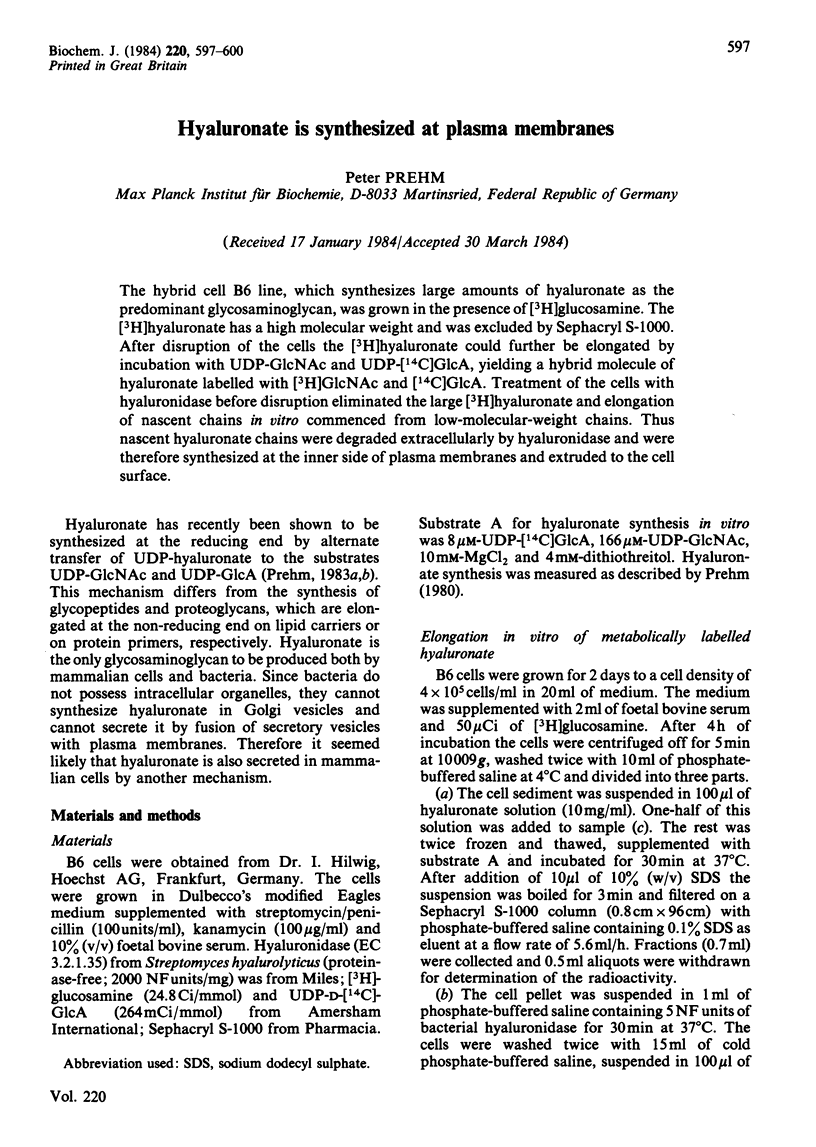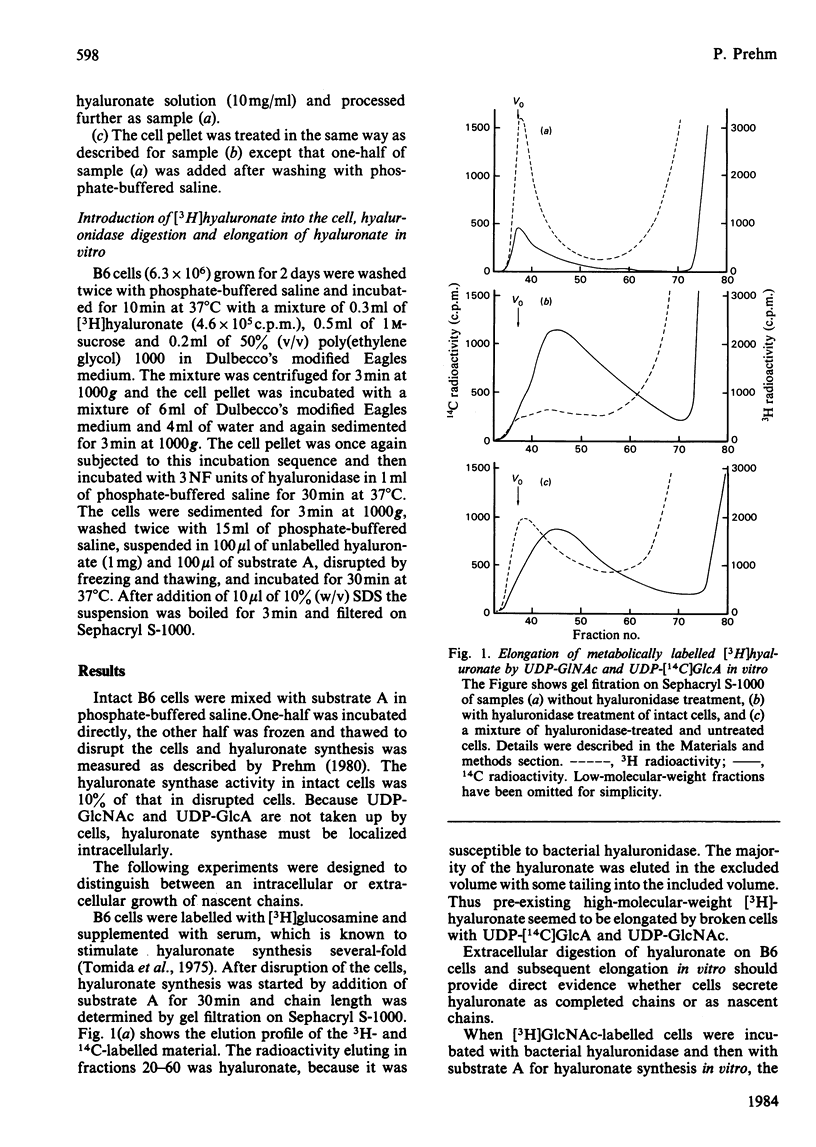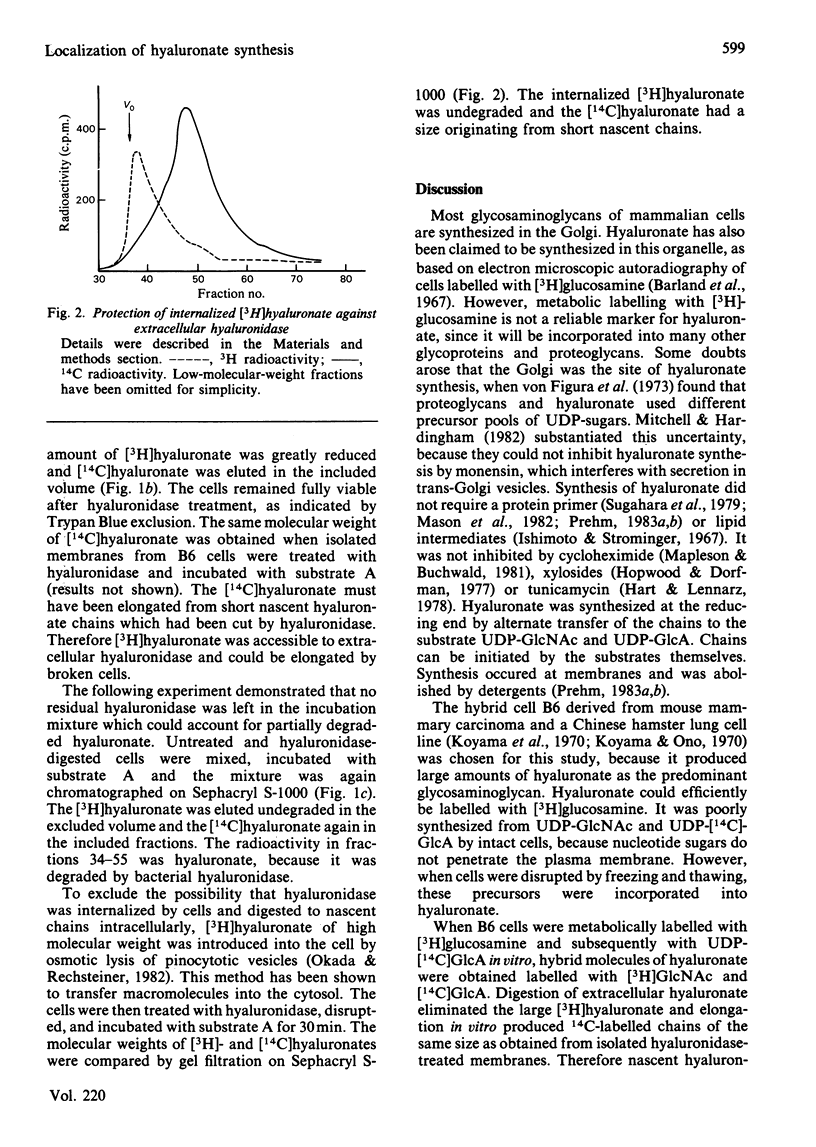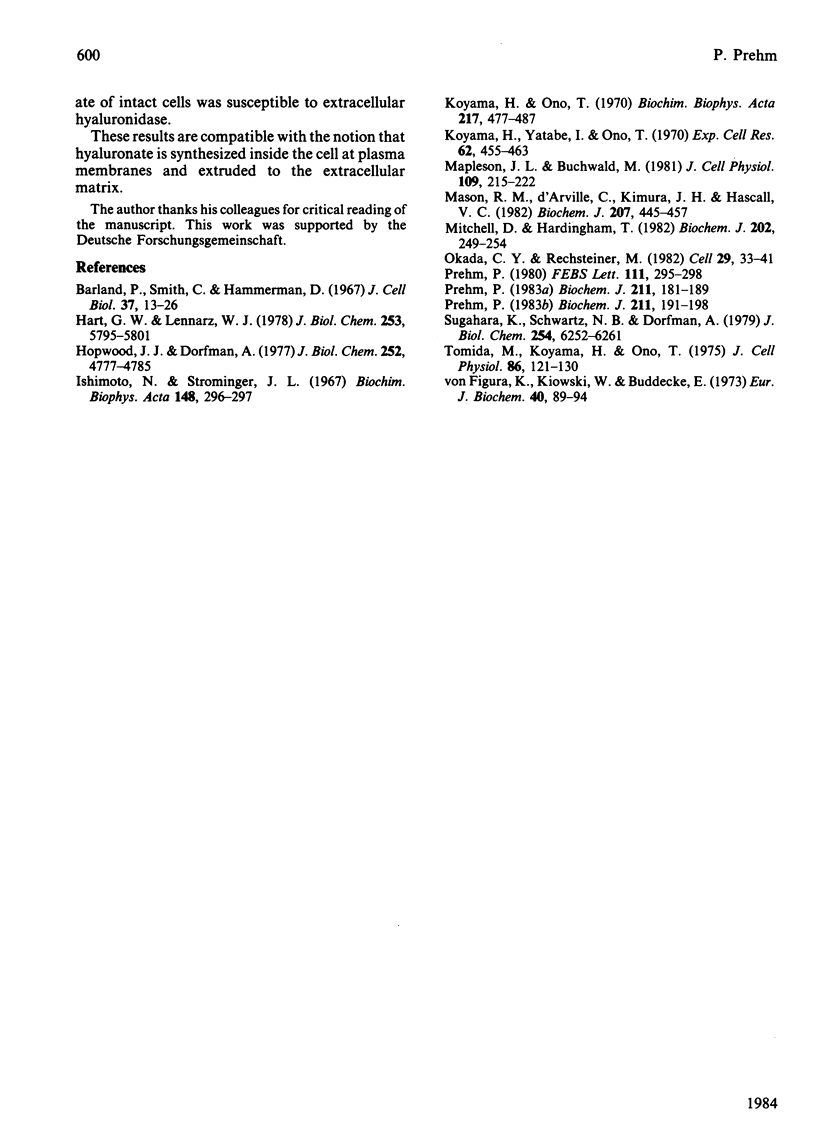Abstract
The hybrid cell B6 line, which synthesizes large amounts of hyaluronate as the predominant glycosaminoglycan, was grown in the presence of [3H]glucosamine. The [3H]hyaluronate has a high molecular weight and was excluded by Sephacryl S-1000. After disruption of the cells the [3H]hyaluronate could further be elongated by incubation with UDP-GlcNAc and UDP-[14C]GlcA, yielding a hybrid molecule of hyaluronate labelled with [3H]GlcNAc and [14C]GlcA. Treatment of the cells with hyaluronidase before disruption eliminated the large [3H]hyaluronate and elongation of nascent chains in vitro commenced from low-molecular-weight chains. Thus nascent hyaluronate chains were degraded extracellularly by hyaluronidase and were therefore synthesized at the inner side of plasma membranes and extruded to the cell surface.
Full text
PDF



Selected References
These references are in PubMed. This may not be the complete list of references from this article.
- Barland P., Smith C., Hamerman D. Localization of hyaluronic acid in synovial cells by radioautography. J Cell Biol. 1968 Apr;37(1):13–26. doi: 10.1083/jcb.37.1.13. [DOI] [PMC free article] [PubMed] [Google Scholar]
- Hart G. W., Lennarz W. J. Effects of tunicamycin on the biosynthesis of glycosaminoglycans by embryonic chick cornea. J Biol Chem. 1978 Aug 25;253(16):5795–5801. [PubMed] [Google Scholar]
- Hopwood J. J., Dorfman A. Glycosaminoglycan synthesis by cultured human skin fibroblasts after transformation with simian virus 40. J Biol Chem. 1977 Jul 25;252(14):4777–4785. [PubMed] [Google Scholar]
- Ishimoto N., Strominger J. L. Uridine diphosphate as the sole uridine nucleotide product of hyaluronic acid synthetase in group A streptococci. Biochim Biophys Acta. 1967 Oct 9;148(1):296–297. doi: 10.1016/0304-4165(67)90305-4. [DOI] [PubMed] [Google Scholar]
- Koyama H., Ono T. Initiation of a differentiated function (hyaluronic acid synthesis) by hybrid formation in culture. Biochim Biophys Acta. 1970 Oct 15;217(2):477–487. doi: 10.1016/0005-2787(70)90545-9. [DOI] [PubMed] [Google Scholar]
- Koyama H., Yatabe I., Ono T. Isolation and characterization of hybrids between mouse and Chinese hamster cell lines. Exp Cell Res. 1970 Oct;62(2):455–463. doi: 10.1016/0014-4827(70)90577-x. [DOI] [PubMed] [Google Scholar]
- Mapleson J. L., Buchwald M. Effect of cycloheximide and dexamethasone phosphate on hyaluronic acid synthesis and secretion in cultured human skin fibroblasts. J Cell Physiol. 1981 Nov;109(2):215–222. doi: 10.1002/jcp.1041090204. [DOI] [PubMed] [Google Scholar]
- Mason R. M., d'Arville C., Kimura J. H., Hascall V. C. Absence of covalently linked core protein from newly synthesized hyaluronate. Biochem J. 1982 Dec 1;207(3):445–457. doi: 10.1042/bj2070445. [DOI] [PMC free article] [PubMed] [Google Scholar]
- Mitchell D., Hardingham T. Monensin inhibits synthesis of proteoglycan, but not of hyaluronate, in chondrocytes. Biochem J. 1982 Jan 15;202(1):249–254. doi: 10.1042/bj2020249. [DOI] [PMC free article] [PubMed] [Google Scholar]
- Okada C. Y., Rechsteiner M. Introduction of macromolecules into cultured mammalian cells by osmotic lysis of pinocytic vesicles. Cell. 1982 May;29(1):33–41. doi: 10.1016/0092-8674(82)90087-3. [DOI] [PubMed] [Google Scholar]
- Prehm P. Induction of hyaluronic acid synthesis in teratocarcinoma stem cells by retinoic acid. FEBS Lett. 1980 Mar 10;111(2):295–298. doi: 10.1016/0014-5793(80)80813-1. [DOI] [PubMed] [Google Scholar]
- Prehm P. Synthesis of hyaluronate in differentiated teratocarcinoma cells. Characterization of the synthase. Biochem J. 1983 Apr 1;211(1):181–189. doi: 10.1042/bj2110181. [DOI] [PMC free article] [PubMed] [Google Scholar]
- Prehm P. Synthesis of hyaluronate in differentiated teratocarcinoma cells. Mechanism of chain growth. Biochem J. 1983 Apr 1;211(1):191–198. doi: 10.1042/bj2110191. [DOI] [PMC free article] [PubMed] [Google Scholar]
- Sugahara K., Schwartz N. B., Dorfman A. Biosynthesis of hyaluronic acid by Streptococcus. J Biol Chem. 1979 Jul 25;254(14):6252–6261. [PubMed] [Google Scholar]
- Tomida M., Koyama H., Ono T. Induction of hyaluronic acid synthetase activity in rat fibroblasts by medium change of confluent cultures. J Cell Physiol. 1975 Aug;86(1):121–130. doi: 10.1002/jcp.1040860114. [DOI] [PubMed] [Google Scholar]
- von Figura K., Kiowski W., Buddecke E. Differently labelled glucosamine-precursor pools for the biosynthesis of hyaluronate and heparan sulfate. Eur J Biochem. 1973 Dec 3;40(1):89–94. doi: 10.1111/j.1432-1033.1973.tb03171.x. [DOI] [PubMed] [Google Scholar]


